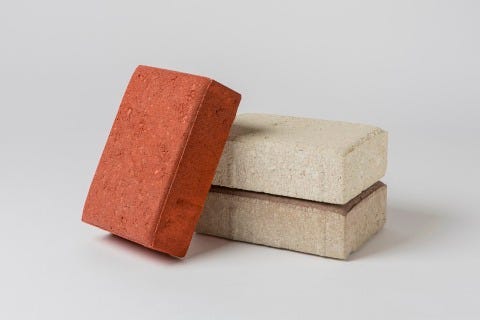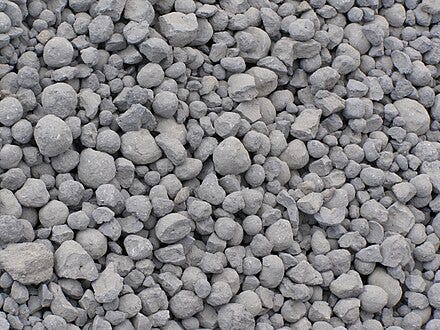Green Cement
The production process, innovations, key players, and opportunities for green cement
After water, cement is the most consumed product in the world. The global cement market is valued at $900B, and it accounts for 7% of global emissions. Green cement is therefore an opportunity for decarbonizing one of the largest industrial sectors and driving sustainable innovation.
Emission Sources in Cement Production
Cement typically makes up 10-15% of concrete, which is made by mixing cement with water and aggregates like sand and gravel. Almost all the emissions in the concrete production process come from cement production.
Most of the emissions from cement production come from the chemical process of turning calcium carbonate to calcium oxide and from the energy needed to heat the kilns. The energy needed for mining, processing, and transportation also factor in as emissions sources.
Raw Material Processing
Portland cement, the most common type of cement in the world, is made by mixing crushed limestone, sand, ground clay, shale, iron ore, and fly ash. Grinding the raw materials into fine powder requires electricity.
Fuel Combustion
The raw meal is preheated in a chamber above a kiln, reaching temperatures of up to 700°C to remove moisture. The kiln is then heated to 750 to 900°C to convert calcium carbonate to calcium oxide (this stage consumes about 65% of the total fuels used) and then to 1,450°C for sintering (fusing together without melting to the point of liquefaction) the clinker. Clinker is made up of dark gray nodules formed from the calcium oxide and other mineral oxides. It acts as the binder in cement when mixed with water.
In the heating process, large amounts of fossil fuels are burned. The fuel combustion process accounts for 30-40% of CO₂ emissions in the cement production process.
Calcination
Calcination is the chemical process in which calcium carbonate (CaCO₃) is heated to produce calcium oxide (CaO). The breakdown of calcium carbonate directly releases CO₂ as a byproduct.
The calcination process accounts for 60-70% of CO₂ emissions in the cement production process.
Transport and Other Operations
The hot clinker is cooled and mixed with gypsum at a ratio of 20-25 to 1. It is ground into a fine gray powder, known as Portland cement, which is then stored or packaged for distribution.
Transporting materials, cooling the clinker, grinding it, and transporting the cement contribute to emissions through electricity and fuel use.
Innovations in Cement Production
There are opportunities to innovate in the cement production process through operational efficiency, technological innovation, and business model reorientation.
Operational Efficiency
Improving plant efficiency, lowering energy intensity, and optimizing equipment performance with advanced analytics could increase plant utilization.
Using alternative fuels like biomass-based fuels could replace fossil fuels.
Using fly ash and alternative binders instead of clinker could significantly reduce emissions from the emissions-intensive clinker production process. The availability and adoption of alternative binders however could vary widely due to local regulations and costs.
Reusing building materials, recycling concrete, and using recycled concrete paste carbonated with CO2 could reduce the need for cement production.
Technological Innovation
Carbon Capture, Utilization, and Storage (CCUS) technologies have the potential to cut emissions by up to 48%. CO2 could be captured as part of the combustion process or from exhaust after combustion. Major cement companies are investing in industrial-scale CCUS facilities that use amine-solvent technology to capture CO₂. The captured CO₂ can be used in industrial and chemical processes, including in concrete curing (adding CO₂ to concrete as it cures reduces cement use and sequesters captured CO2), biochar production, and enhanced oil recovery, or it can be permanently stored underground.
Business Model
Demand for sustainable materials in buildings is increasing. Design innovation, including through multi-unit buildings and new material mixes, could reduce cement use. Also, alternative materials like cross-laminated timber (CLT) and innovative approaches like advanced insulation technologies, prefabrication, and 3D printing could also reduce emissions.
Key Players
The largest cement companies in the world include Lafargholcim, Anhui Conch, China National Building Materials, HeidelbergCement, Cemex, and Portland Cement. Many of these are partnering with green cement startups to transition to a more sustainable production process. The following seven startups are innovating in the space:
Brimstone
Brimstone makes Portland cement from calcium silicate rocks, which contain no CO2, instead of from limestone. These rocks fit almost seamlessly into the existing cement supply chain. Brimstone is focused on Portland cement despite the high heat required in its process because it is the global industry standard. Brimstone plans to use electric kilns.
Sublime Systems
Sublime Systems uses an electrochemical approach, powered by renewable electricity, to create carbon-free lime, which is then combined with reactive silica. Its process does not require high heat or combustion, and its product reacts with water similar to the way Portland cement does.
Cemvision
Cemvision makes net-zero cement by using industrial byproducts instead of limestone. This circular economy approach reduces CO2 emissions and extraction of materials. Cemvision has also electrified its production process.
Terra CO2
Terra CO2 makes supplementary cementitious materials (SCMs) from silicate-based raw materials found near existing aggregate mines. SCMs are already used to reduce clinker in cement, and now, Terra CO2 is using SCMs to reduce cement in concrete.
Ecocem
Ecocem makes cement with reduced clinker content and low carbon SCMs through its scalable Accelerated Carbonation Technology (ACT). It plans to reduce cement’s global carbon footprint by 70% by 2035 with similar production costs and manufacturing processes and reduced energy and water use. Ecocem has already developed and delivered 20M tonnes of cement and prevented 16M tons of CO₂.
CarbonCure
CarbonCure injects captured CO2 into Portland cement. The CO2 reacts with calcium ions in the cement and mineralizes. This makes the cement denser and stronger, and the cement serves as long-term storage for the CO2.
Solidia Technologies
Solidia Technologies mixes cement powder and sand and then adds water and CO2, which reacts with the cement to make calcium carbonate and silica. These harden into a stronger concrete that is more resistant to cracking in extreme temperatures.
What’s next?
Cement production is projected to increase by 45% globally by 2050 due to urbanization, especially in India, Africa, and Southeast Asia. The need for low-cost green cement is therefore essential.
Given how large the cement industry is, it may be a challenge for green cement startups to enter the market. However, if established cement companies partner with green cement startups, the green cement innovations can be combined and scaled.
Additional technologies, including nanoengineering, modular construction, and information technology modeling systems can also reduce the use of concrete and cement.
Investment in green cement and CCUS equipment has reached $60B per year. With more collaboration across the cement industry as well as sustained investment and innovation, green cement could become ubiquitous and significantly reduce global CO2 emissions.





